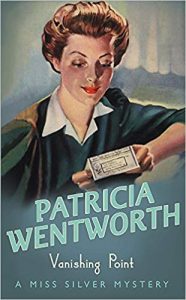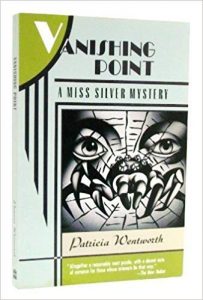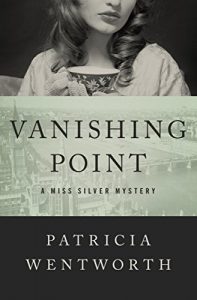
Still waters run deep.
That’s the theme of this classic English country-house mystery. The village of Hazel Green is as peaceful on the surface as a woodland pond. But over the years, a series of disappearances create disturbing ripples: A lonely housemaid vanishes from her parents’ cottage. A priceless ring vanishes from an heiress’ party. A long-awaited engagement vanishes overnight. These are murky waters, and there’s something nasty brewing at the bottom of it all.
Patricia Wentworth was a practiced hand at writing mysteries by the time she completed Vanishing Point in 1953, and she takes her time before bringing her detectives onstage. First, she gets us thoroughly invested in the dreams and heartaches of Rosamund Maxwell and her younger sister Jenny. The Maxwell sisters are the resident “poor relations” to their domineering aunt Lydia Crewe. Orphaned, and with Jenny disabled, they survive in Dickensian dependency on Miss Crewe’s grudging graces.
As the price of their living, Rosamund shoulders the herculean task of keeping the elegant family home in a semblance of its former glory, with a tenth of the staff and no money at all. Twelve-year-old Jenny whiles away her invalid hours reading trashy romances and aspiring to write them.
Jenny creates the first eddy in Hazel Green’s dark surface by sending one of her manuscripts to a London publisher. Intrigued by her moxie — and by the photograph of Rosamund she tried to pass off as her own — publisher Craig Lester pays an unexpected call. Craig and Rosamund’s budding romance teeters on the edge of trite. But the author uses a light touch. She makes both characters so likeable, and sets Jenny’s pulpy melodramas to such effective contrast, that the love story weaves through and supports the mystery as a charming frame.
It’s not until Chapter Five that we meet Detective Inspector Frank Abbott, and Chapter Six that he invokes the aid of his distant cousin, Miss Maud Silver. Miss Silver and Inspector Abbott are Patricia Wentworth’s well-established duo, having appeared in 32 novels (Vanishing Point is number 25).
Abbot is a posh policeman in the style of Ngaio Marsh’s Inspector Alleyn, but with a playful sense of humor and a penchant for deux-ex-machina derring-do. Though bright and capable at police work, his main asset in detection is an endless supply of family connections, which give him cover stories and insider tips for cases in any part of the British Isles.
Miss Silver is a retired governess who works hard at remaining inconspicuous. Her deliberately old-fashioned clothes and constant knitting are an obvious tweak at Miss Marple. But as a professional undercover sleuth, she’s quite businesslike about her approach to cases, and not afraid to get her hand in at the denoument.

The New Yorker damned Vanishing Point with faint praise in its original review: “Altogether a reasonably neat puzzle, with a decent note of romance for those whose interests lie that way.” For some reason, HarperCollins thought this was a great quote for the cover of its 1991 paperback reissue.
I agree more with the New York Times: “You should try Patricia Wentworth’s Vanishing Point as a case singularly well suited to her…Our Maud prevents the last murder in a manner possible to no other fictional sleuth. Long, slow, unsensational, and, to the proper palate, delightful.”
Literary snobs could look down on Wentworth’s stories as derivative, formulaic or hackneyed. I daresay they’re right, but we don’t read cozy mysteries to be literary snobs. We read them for enjoyment, and Vanishing Point is full of atmospheric, innocent enjoyment. There’s just a hint of Northanger Abbey about this book, in the way its Gothic overtones unfold to a more prosaic — but more satisfying — conclusion.
The book begins in a gloomy wood, in a stagnant village full of secrets and suspicions. It unravels a longstanding, sinister puzzle and ends in a beam of sunshine, with lovers finally released from fear and moving toward a happy future.
What’s not to like?
If you prefer fast plots with lots of action and hijinks, you might skip this one. But if you appreciate moody suspense with some fun twists at the end, this is a great companion for a cup of tea on a rainy afternoon. Four stars and two lumps of sugar, please.

Vanishing Point is available in Kindle, paperback, or Audible audiobook.
By request, I include a “Squick Factor” rating on reviews, to give tenderhearted readers a heads-up on graphic or disturbing material.
I’m wracking my brain to come up with something that might set off the squick-ometer, and I can’t think of a single thing. All the violence is offstage, and the romance is as chaste and proper as any doyenne might wish since we started wearing skirts above our ankles. I give the story a Squick Factor of 0.
Squick Factor Range:
0 – Nil.
1 – Meh.
2 – Kinda.
3 – Oh yah, you betcha.
4 – GAAAHHH! Nuke it from space!
Browse my blog for more reviews, and sign up for my newsletter to receive recommendations of free and discount books!